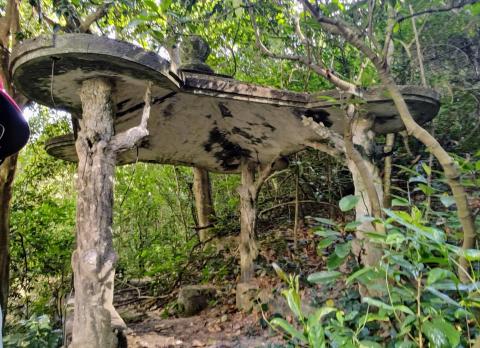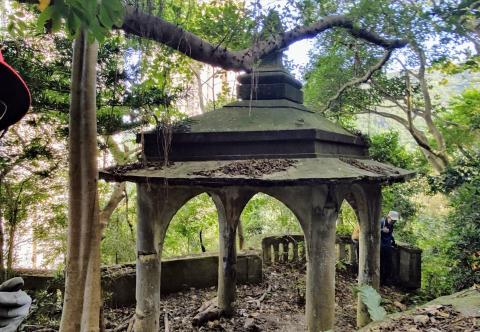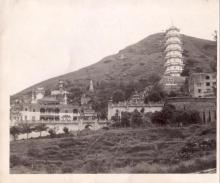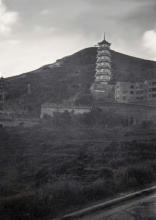Current condition
Ruin
This is one of the three pavilions found on the knoll behind Tiger Balm Garden. There are broken steps between them, and numerous glass bottles are found among debris at the lower part of the slope.
For the exact location of this one and the one further downhill, please check the Geo Info Map online, they are shown in the large scale version of the Map. https://www.map.gov.hk/gm/geo:22.2739,114.1954?z=1361
This one is at the lowest level, near Tai Hang Drive.
This is the one in mid-level of the hill.





Comments
Re: Pavilions
Given the war years, I doubt very much the Government would have built the trails and the pavilions originating from Tiger Balm Gardens. Looks like the trails and pavilions were present prior to end of WWII.
The styles of the pavilions
The styles of the pavilions look similar to some of those within the Garden, though not Chinese.
Re: styles
Here's a collage of the three pavilions in the 1950s and in 2020.
AW Chu Kin memorial, not tomb
Hi Phil,
You are right. As shown in the inscription on the pagoda, it was a memorial of AW Chu Kin, not his tomb.
A Google search showed that the plaque with the inscription was re-installed on a smaller monument in Yongding County, Fujian Province which was his hometown. Please see here and here.
Hi H Lo,
I doubt if the staff of the Foundation has much knowledge about the history of the Garden. However, maybe she can ask Ms. Sally Aw!
It is great to see that there are good discussions on this page.
Memorial
Thanks for confirming C. The images I usually see of this structure usually show the Nationalist star emblem that was fixed on one side. That coupled with the Double Tenth gate on the steps leading up to it always made me wonder if the demolition of this part of the garden may have also been an attempt by the Aw family to not make the garden a target following the 67 riots.
Pagoda
Thanks for that link as well. If you scroll down you can see they have also erected what looks to be a replica Tiger Pagoda somewhere in the village. So it looks like it lives on after all (another user had commented previously in another thread about Li ka shing would have preserved it). On closer examination and comparisons I think this is definitely a copy. The door sizes on the various levels seem to be slightly different to the original. But perhaps some elements were preserved and reused in the same vein as Murray Barracks in Stanley?
This page has stated that the
This page has stated that the pagoda was donated by Sally Aw in memory of his father. The one in HK had been used as a reference.
http://www.tanluxia.com/38867/
Klaus, thanks for the collage, I've been planning to make one but never really taken any action.
Tiger Balm Garden and Li Ka-shing
Hi Phil,
Thank you for your messages. I probably walked through the Double-Tenth gate as a kid, but have no memory of it. I am not sure the demolition of a part of the Tiger Balm Garden was influenced by politics. The British colonial government did a good job in uprooting the underground networks of the Nationalist and Communists after the respective riots (1956 and 1967). At a civic level, the Nationalist remained influential into the late 1980s, with Sing Tao Daily (then owned by Sally Aw) using the Republic of China year numbering instead of A.D.
Some decorative elements of the Tiger Balm Garden were preserved, e.g. sculptures of lion and tiger. Unfortunately, the staff at the Aw Boon Haw Foundation said that the pair of soldiers in porcelain guarding the entrance to the Haw Par Mansion were lost.
I find it a bit amusing that someone thought Li Ka-shing would have preserved the Tiger Pagoda. We only need to look at '1881 Heritage' with much of the hill flattened and a few trees 'preserved' in huge flower pots at the top of tall columns. With much of the roots gone, no wonder they could not withstand typhoons.
Porcelain craftsmen
BTW, the 2 masters that made those porcelain figures were from the famous porcelain capital of China Jingdezhen 景德鎮. They subsequently opened their own factory in Lei Yui Mun to make and export ceramic articles to the west. Their products had more of an east-meets-west type of aesthetics instead of the traditional Chinese designs.
pavilions
the thing that strikes me most about these three pavilions is that the style of the canopies are very much keeping in with the rather surreal nature of the garden itself and therefore make me think they may well be related to the garden in some way. It's certainly not beyond belief that the AW family built them at some point, perhaps just for public use rather than for them to be part of the garden itself. They appear to be quite unique in their design compared to the normal type of pavilion found in HK.
1945 Tiger Balm Gardens
Noted this photo from 1945 of the Tower and the pavilions on the hillside. The photo is related to HMCS Prince Robert's time in Hong Kong from 30 August 1945 till returning to Canada with liberated POWs in October 1945.
Pavilions
Following C's previous comment, I went to the mansion yesterday and bought Tiger Balm Gardens: A Chinese Billionaire's Fantasy Environments by Judith Brandel and Tina Turbeville, which is currently on sale for $250 (half price). Inside is a picture of a pavilion at the Singapore gardens with 4 circular shapes at each corner - similar to the one above. The Singapore pavilion appears to have been following the style of the Haw Par Villa in SGP that was designed around a circular disc style. It's not conclusive but perhaps this adds a bit of weight to the idea that even though they may not have been part of the garden itself, they may have been designed and built by the same person. The book mentions both HK and SGP gardens were worked on by a pair of brothers from Fujian called Kwek Hoon Sua and Kwek Choon Sua.
Also, I can confirm that the rear portion of the gardens was sold in 1978 by the company that owns the mansion (controlled by one of Aw Boon Par's sons). Apparently there had already been an attempt to sell in 1961 that was fought off by Sally Aw and her mother who were still living in the house at the time.
Lot no. GLA-HK 639
Millions thanks for your information.
Just noticed that the topmost pavilion seems to be situated just out of Lot no. GLA-HK 639 where the service reservoir and its relevant facilities are.
https://www.map.gov.hk/gm/geo:22.2728,114.1954?z=1128
pavilions
I would also venture that Aw Boon Haw was a notable philanthropist who opened the gardens to the public for free. The area where the reservoirs are now used to just be a plain hilltop, and it wouldn't surprise me if we found out he had these pavilions built for the beneift of people who wanted to walk to the top to admire the view. It seems like the sort of thing a person like him would have done. It's just my opinion though.
top pavilion
Found this drawing on Flickr. The top pavilion is clear to see (artists love to emphasize certain features), and it's in the middle of nowhere and seems to have no connection with the garden.
.
I have followed the recent
I have followed the recent posts with great interest. As I suggested some time ago, it does now seem likely to me that the topmost pavilion and even perhaps the middle and lower ones were some way up on the hillside on land that was not actually part of the land owned by the family. It is interesting to see on the latest map that paths are shown rising up from the garden to the lower and middle pavilions, and then more or less to the top pavilion. Am I right in seeing a date of 1939 at the bottom right of the map? Did the family have a short lease on that land or did they just build the pavilions for the benefit of all, and the authorities turned a blind eye to them? It has been a fascinating discussion.